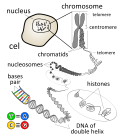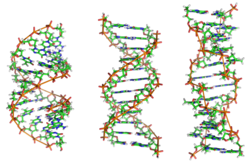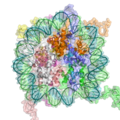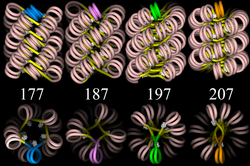Chromatin
(Redirected from Euchromatin)
Chromatin is the complex combination of DNA and proteins that makes up chromosomes.[1][2] It is found inside the nuclei of eukaryotic cells.
Chromatin is divided into heterochromatin (condensed) and euchromatin (extended) forms.[3][4] Heterochromatin is composed mostly of satellite DNA tandem repeats. The active components of chromatin are DNA and histone proteins, although other proteins also occur.[5] The functions of chromatin are:
- to package DNA into a smaller volume to fit in the cell
- to strengthen the DNA to allow mitosis and meiosis
- to control DNA replication and gene expression. How this works is not yet clear.
Chromatin definitions
- Simple and concise definition: Chromatin is a macromolecular complex of a DNA macromolecule and protein macromolecules (and RNA). The proteins package and arrange the DNA and control its functions in the cell nucleus.
- The DNA + histone = chromatin definition: The DNA double helix in the cell nucleus is packaged by special proteins termed histones. The formed protein/DNA complex is called chromatin. The basic structural unit of chromatin is the nucleosome.
Chromatin Media
References
- ↑ Van Holde K.E. 1989. Chromatin. New York: Springer-Verlag. ISBN 0-387-96694-3
- ↑ Cooper, Geoffrey M. 2000. The Cell: a molecular approach. 2nd ed, Chapter 4.2 Chromosomes and Chromatin
- ↑ "Chromatin Network Home Page". Archived from the original on 2011-08-13. Retrieved 2008-11-18.
- ↑ Dame R.T. (2005). "The role of nucleoid-associated proteins in the organization and compaction of bacterial chromatin". Mol. Microbiol. 56 (4): 858–70. doi:10.1111/j.1365-2958.2005.04598.x. PMID 15853876. S2CID 26965112.
- ↑ Van Holde K.J. et al 1995. Elements of chromatin structure: histones, nucleosomes, and fibres, p. 1-26. In S.C.R. Elgin (ed) Chromatin structure and gene expression. IRL Press at Oxford University Press, Oxford.
+{{{1}}}−{{{2}}}







